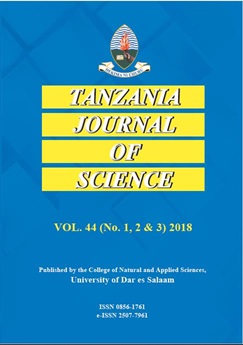Generation of Geochemical Exploration Targets from Regional Stream Sediment Data Using Principal Component and Factor Analysis: A Case Study of Kibaya-Kiteto, Manyara-Tanzania
DOI:
https://doi.org/10.4314/tjs.v48i3.14Abstract
A regional-scale stream sediment geochemical sampling was carried out with an average sampling density of one sample per nine square-kilometre in Kiteto District, Manyara Region. A total of 358 stream sediment samples were collected and analysed for major and trace elements by X-ray fluorescence (XRF) and fire assay with atomic absorption spectrometry (AAS) finish methods. In this study, Factor and Principal Component Multivariate (FPCM) analyses have been used to the stream geochemical data to delineate potential mineralization zones by plotting correlated factors as geochemical anomaly maps. Four factors that account for 73.7% of the total variance of the stream sediment geochemical data were established. Factor 1: Ni €“Ba €“Co €“Cu €“Sr which possibly defines the underlying metamorphosed granitic units with some contribution from mafic and ultramafic rocks. Factor 2: Cr €“Zn €“Mn which defines crustal forming elements reflecting the mafic rocks. Factor 3 which entails Rb and Pb probably attributed to metamorphosed granitic lithology. Factor 4 is arsenic, a chalcophile element with affinity to sulfide phases. The FPCM analyses have been successfully in delineating potential target areas for gold, nickel and copper exploration in the study area.
Keywords: Stream sediment; principal component; factor analysis; exploration targets; Kibaya-Kiteto, Manyara.


